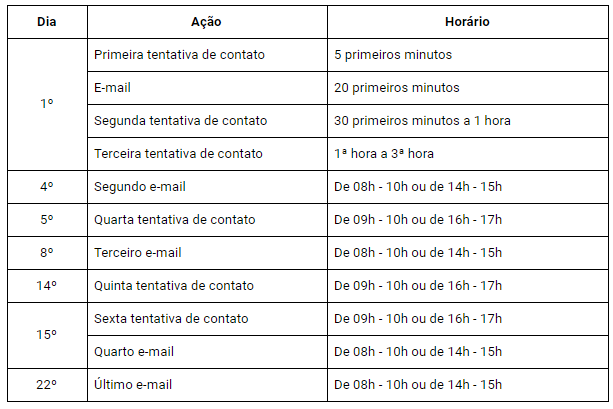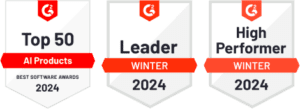Did you know that the chances of generating a sale decrease dramatically with the time it takes to make the first contact? There is a direct relationship between the time it takes to contact a lead and the chance of a successful sale.
That's why in this article we've listed three studies used here at Pareto to increase the conversion rate of commercial teams. They are:
- MIT (Massachusetts Institute of Technology) - The first study to be dealt with is the one carried out by MIT (and cited by Forbes), which cross-referenced data on contact time and lead qualification and the success of each action;
- Velocify - The second study was carried out by the company Velocify, which, in addition to considering the action time for calls, also considered communication by e-mail, showing the relationship between contact time and successful qualification.
- Kissmetrics - The third and final study was carried out by Kissmetrics and features an infographic with the best times to send an email.
Read on and find out more about each study. How the methodologies work and how they can be applied to your lead capture strategy.
1. MIT - Massachusetts Institute of Technology
This study was conceived from the understanding that there is a knowledge gap between the Marketing and Sales areas.
This is due to a common market practice: in general, companies use the intuition and experience of their employees to manage a lead's response time rather than scientific data. That's why the proposal was to put an end to this disparity and present statistical results to help with decision-making.
They identified which day of the week, which time of day and which time from the arrival to the return of a lead* were the best for obtaining optimum contact and qualification rates.
The data used was taken from the InsideSales.com system, a key platform for this purpose, as it generates and stores quantitative data from calls directly linked to qualitative information on processes and lead flows.
Three years of data were examined from 5 companies that generated and responded to leads, totaling more than 15,000 leads explored and more than 100,000 call attempts analyzed.
Results obtained
The results showed when sales reps were most successful in calling their leads, considering leads that were captured by an online form and contacted, or attempted to be contacted, at least once.
Take a look at the most interesting facts found relating to speed and response time:
Best Day
Wednesday and Thursday are the best days to call, 49.7% better than the worst day (Friday). They are also the best days to qualify, 24.9% better than the worst day. Thursday is the best day to get in touch in order to qualify the lead, 19.1% better than the worst day.
Best time
4pm to 6pm is the best time slot to call, being 114% better than the worst time slots, which are 11am to 12pm and 1pm to 2pm. The intervals from 9am to 10am and from 4pm to 5pm are the best times to qualify a lead, being 164% better than the block from 1pm to 2pm, the worst time of day. Now, 4pm to 5pm is the best interval for qualifying a lead, beating the worst interval by 109%.
Best moment
The chances of contacting the lead drop by more than 10 times if we compare the first attempt as soon as the lead arrives and an hour later. The chances of qualifying the lead drop by more than 6 times in that first hour. After 20 hours, every additional contact attempt your sales team makes actually hurts your chances of making contact with a qualified lead.
Best stage of the funnel
The chances of contacting a lead increase by up to 100 times if the action is taken within 5 minutes of entering the funnel, compared to an attempt after 30 minutes. As for qualification, the chances increase by up to 21 times if contact is made within the first 5 minutes compared to 30 minutes.
What's the urgency?
The probability of a successful conversion if the lead is contacted in the first minute is 394%, compared to a probability of 160% in the second minute, i.e. the probability of success drops by more than 50% in just one minute, reaching 62% after 30 minutes.
2. Velocify
The subject of this study is how we can use phone calls and e-mails to achieve successful conversions. The research builds on a previous study and adds e-mail as a form of contact to increase the chances of success.
The data used was generated by more than 3.5 million leads, from more than 400 companies covering a variety of industries. The organizations represented in the study were selected at random.
What's interesting is that they warn that, although it can serve as a starting point for practically any sales team, the most important thing to note is that the study reflects an aggregate of hundreds of organizations in many different types of industries.
Therefore, the best contact strategy for a given organization is often influenced by its industry. And also the type of product being sold and the nature of the sales process in question.
Results obtained
The conclusions reached here show the relationship between contact speed and conversion success. As well as the number of attempts and the use of emails in the best possible way within a contact strategy.
Check out the most interesting facts about contact speed:
Contact speed
Call speed is the most significant driver of conversion rates - making a call attempt within a minute of receiving a lead increases conversion rates by 391%.
Number of Contacts
93% of all converted leads are contacted in six or fewer contact attempts. Leads who need seven or more attempts have a 45% lower chance of conversion than those who need six or fewer attempts, and are therefore not worth spending time and resources on.
Duration of Contact
Conversion rates can be increased by timing contact attempts appropriately. An average gain of 49% in conversion can be achieved with the recommended length of calls.
Contact Type
Leads who are sent emails between telephone contact attempts have a 16% greater chance of being contacted by phone. An average gain of 53% in conversion can be achieved with the recommended time to send an email. Combining telephone and email strategies can result in a conversion gain of 128%.
3. Kissmetrics
The study was summarized in a cool infographic about the best times not only to send an email, but also to be active on social networks, i.e. to make posts.
Results obtained
Find out what the most interesting conclusions of the study were:
Best time
From 6 a.m. to 10 a.m., people are already "content" to spend their time reading emails, as this is the start of the working day and is one of the most recommended times.
From 2pm to 3pm is the start of the second work shift, so it's common for people to pay attention to their emails. From 3 p.m. to 5 p.m. it has been observed that people start to think about their personal issues rather than work, so it's not the most appropriate time.
If the aim is to contact companies, then the hours of 5pm to 7pm also work. If you're interested in contacting the end consumer, the best time to do so is from 7pm to 10pm.
Best Frequency
The best frequency for sending emails is between 1 and 4 times a month.
Obviously, if you contact a lead and they ask you to send them content by email, the ideal is to do this as soon as possible. If you can't, keep an eye on the timetable so that the email doesn't get lost in your lead's inbox.
How to Improve Your Conversions Based on the 3 Studies?
The studies have similar themes and complementary results.
The first two indicate an increase in the likelihood of conversion for leads that are contacted within the first few minutes of entering the sales funnel (394% and 391%, respectively).
While the first provides the best days and times for qualification, the second presents a combined strategy of actions to maximize contact. The third complements the first two, indicating the best times to contact the lead via email.
Proposed Actions for Contacting Leads
In terms of planning and action, Velocity has an interesting proposal for actions based on the results obtained in terms of conversion gains:
Day 1:
Call the lead immediately. If they don't answer and/or don't call back, send the first email after 20 minutes. After 30 minutes, try another call and, if that doesn't work, try again within one to three hours of the lead's arrival.
Day 4:
Second e-mail to the lead;
Day 5:
Fourth attempt to contact the lead;
Day 8:
Third e-mail to the lead;
Day 14:
Fifth attempt to contact the lead;
Day 15:
Fourth e-mail and sixth attempt to contact the lead;
Day 22:
Last email to the lead.
If we consider the conclusions of the first study, it may not always be possible to fit the actions proposed in this strategy into the best day for contact/qualification.
However, you can consider the best times of the day and thus intensify your chances of results!
Remember that 4pm to 6pm was the best time to call? So why not make the fourth call attempt - which, according to the strategy, would take place three days after the first day of attempts - at that time?
Now, when it comes to emails, the first hours of each work shift (9am to 10am and 2pm to 3pm) are the best. You can also use the late afternoon, from 5pm to 7pm for B2B leads or 7pm to 10pm for B2C leads.
By unifying all the information acquired so far, it is possible to complement the action strategy.
Below is an example of a sequence of actions to intensify a qualification:

Remember that you won't be able to make all the best decisions for every lead. So don't worry if you can't carry out some of these actions.
The most important thing is to contact your lead IMMEDIATELY and, if that's not possible by phone, by email. Use this as a guide and train yourself so that you, or your sales team, can achieve more and more sales success!
To delve even deeper into the subject, check out this other article on our Blog about Automatic Lead Qualification by Email Type (Personal vs. Professional).



